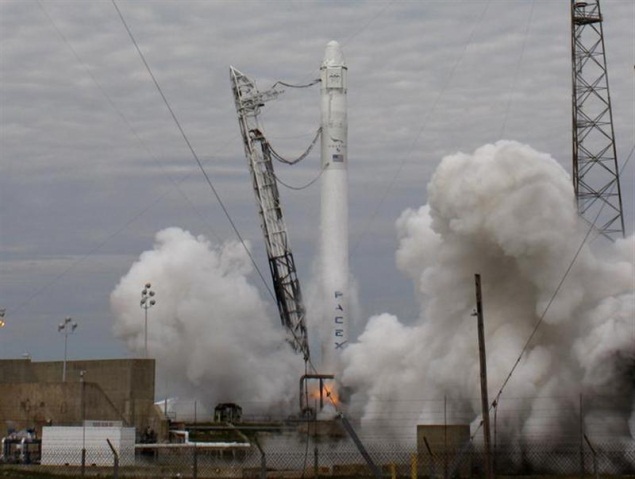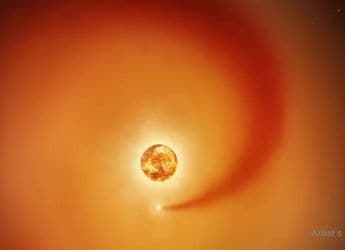- Home
- Others
- Others News
- SpaceX cargo capsule reaches International Space Station
SpaceX cargo capsule reaches International Space Station

Astronauts aboard the outpost used the station's robotic arm to pluck the capsule from orbit at 5:31 a.m. EST/1031 GMT as the ships sailed 250 miles (400 km) over northern Ukraine.
Flight controllers at NASA's Mission Control in Houston then stepped in to drive the capsule to its berthing port on the station's Harmony connecting node. Docking occurred at 8:44 a.m. EST/1344 GMT.
The Dragon capsule, loaded with more than 2,300 pounds (1,043 kg) of science equipment, spare parts, food and supplies, blasted off from Cape Canaveral Air Force Station in Florida on Friday aboard a SpaceX Falcon 9 rocket for the second of 12 planned supply runs for NASA.
SpaceX is the first private company to fly to the station, a $100 billion project of 15 nations.
Dragon was to have arrived at the station on Saturday but a problem with its thruster rocket pods developed soon after reaching orbit. Engineers sent commands for Dragon to flip valves and clear any blockage in a pressurization line in an attempt to salvage the mission.
By Friday evening, Dragon had fired its thruster rockets to raise its altitude and begin steering itself to rendezvous with the station.
The orbital ballet ended when station commander Kevin Ford, working from a robotics station inside the outpost, grabbed the capsule with the station's robot arm.
"As they say, it's not where you start but where you finish that counts. You guys really finished this one on the mark," Ford radioed to Dragon's flight control team in Hawthorne, California, and NASA's Mission Control in Houston.
"What a fantastic day," Ford said.
Once Dragon's hatch is open, the station crew will spend the next several days unpacking the food, clothing, supplies and science experiments from the capsule. The research includes studies on plant seedlings, mouse stem cells and combustion in microgravity.
SpaceX also sent the crew a gift of fresh fruit from an employee's father's orchard, company president Gwynne Shotwell said.
Ground controllers will use the station's robot arm again on Wednesday to unpack equipment for a future spacewalk that is stowed in Dragon's unpressurized trunk.
Once the capsule is unloaded, the crew will begin refilling it with 3,000 pounds (1,361 kg) of unneeded and broken equipment and science samples for analysis on Earth.
Dragon is the only station freighter that makes return trips, a critical service that was lost after the U.S. shuttle program ended in 2011. Cargo ships flown by Russia, Europe and Japan incinerate in the atmosphere after leaving the station
Dragon's departure and parachute splashdown in the Pacific Ocean is scheduled for March 25.
Dragon's flight is the second of 12 missions for privately owned Space Exploration Technologies, known as SpaceX, under a $1.6 billion NASA contract. Following a successful test flight to the space station in May 2012, SpaceX conducted its first supply run to the orbital outpost in October.
A second firm, Orbital Sciences Corp is due to debut its freighter this year.
NASA turned to private companies for delivering supplies to the station following the retirement of its shuttle fleet. The agency hopes to buy rides commercially for its astronauts as well beginning in 2017.
© Thomson Reuters 2013
Catch the latest from the Consumer Electronics Show on Gadgets 360, at our CES 2026 hub.
Related Stories
- Samsung Galaxy Unpacked 2025
- ChatGPT
- Redmi Note 14 Pro+
- iPhone 16
- Apple Vision Pro
- Oneplus 12
- OnePlus Nord CE 3 Lite 5G
- iPhone 13
- Xiaomi 14 Pro
- Oppo Find N3
- Tecno Spark Go (2023)
- Realme V30
- Best Phones Under 25000
- Samsung Galaxy S24 Series
- Cryptocurrency
- iQoo 12
- Samsung Galaxy S24 Ultra
- Giottus
- Samsung Galaxy Z Flip 5
- Apple 'Scary Fast'
- Housefull 5
- GoPro Hero 12 Black Review
- Invincible Season 2
- JioGlass
- HD Ready TV
- Laptop Under 50000
- Smartwatch Under 10000
- Latest Mobile Phones
- Compare Phones
- OnePlus Turbo 6V
- OnePlus Turbo 6
- Itel Zeno 20 Max
- OPPO Reno 15 Pro Mini 5G
- Poco M8 Pro 5G
- Motorola Signature
- Vivo Y50e 5G
- Vivo Y50s 5G
- Lenovo Yoga Slim 7x (2025)
- Lenovo Yoga Slim 7a
- Realme Pad 3
- OPPO Pad Air 5
- Xiaomi Watch 5
- Huawei Watch 10th Anniversary Edition
- Acerpure Nitro Z Series 100-inch QLED TV
- Samsung 43 Inch LED Ultra HD (4K) Smart TV (UA43UE81AFULXL)
- Asus ROG Ally
- Nintendo Switch Lite
- Haier 1.6 Ton 5 Star Inverter Split AC (HSU19G-MZAID5BN-INV)
- Haier 1.6 Ton 5 Star Inverter Split AC (HSU19G-MZAIM5BN-INV)

















